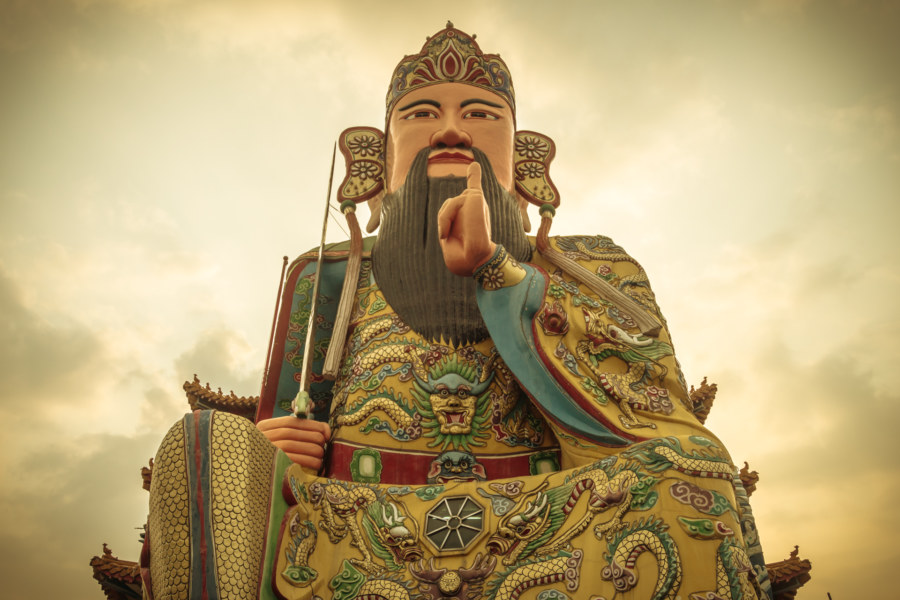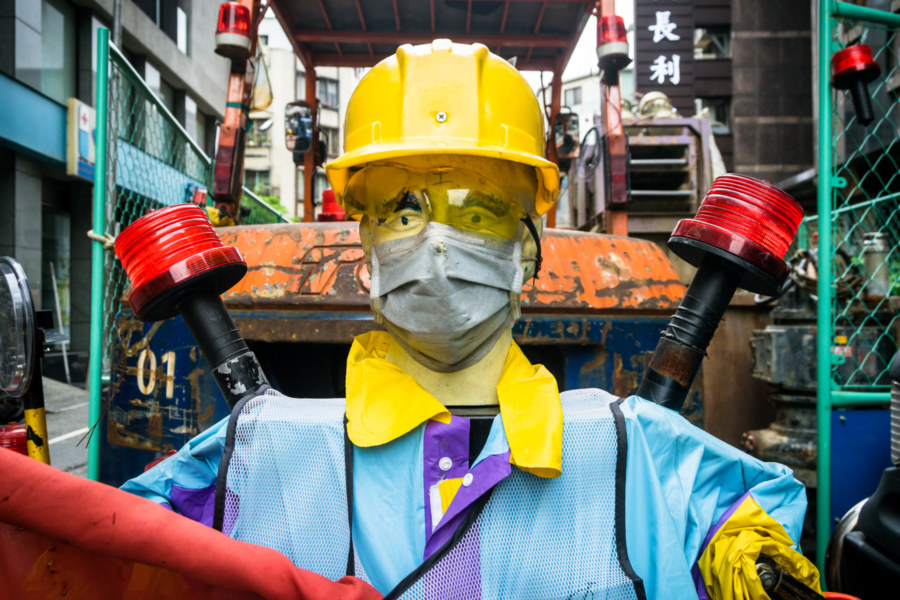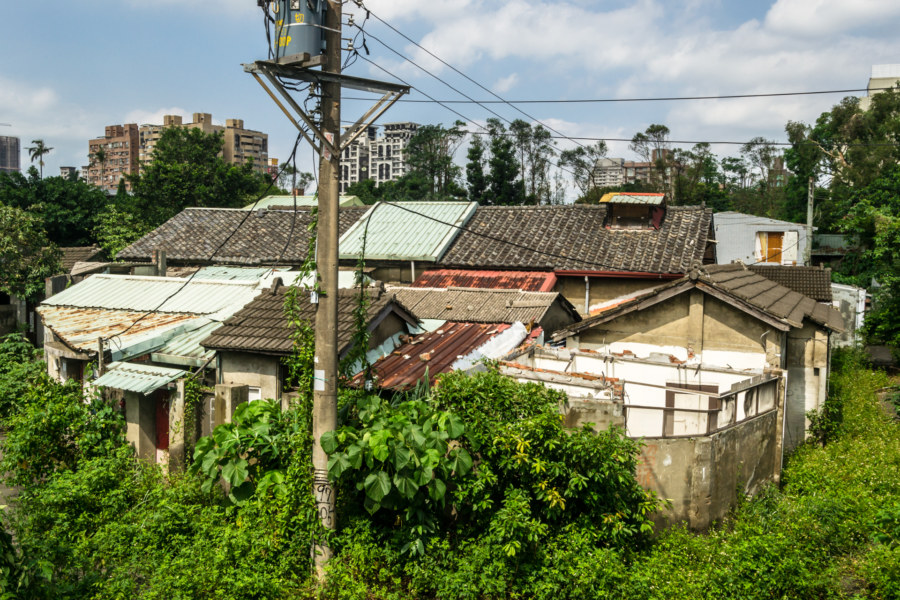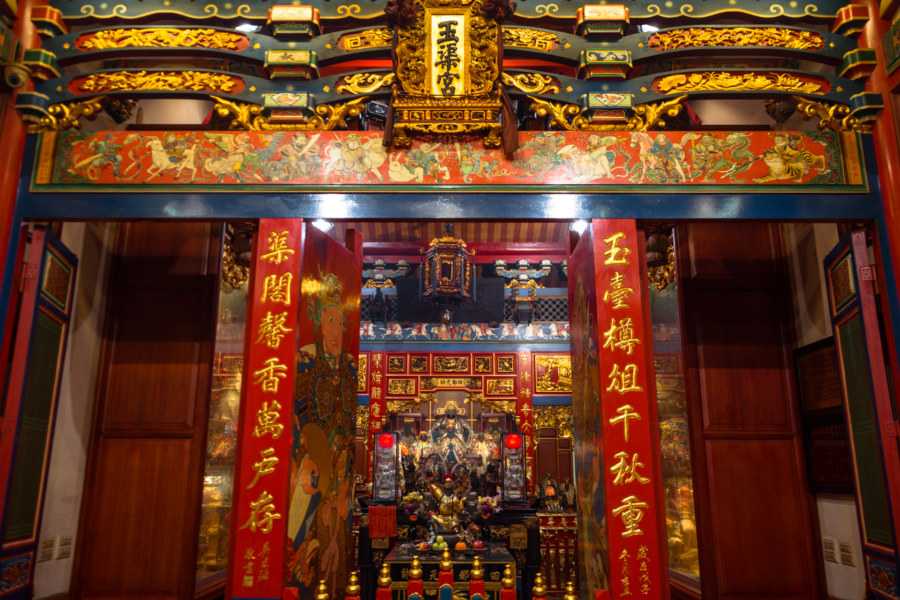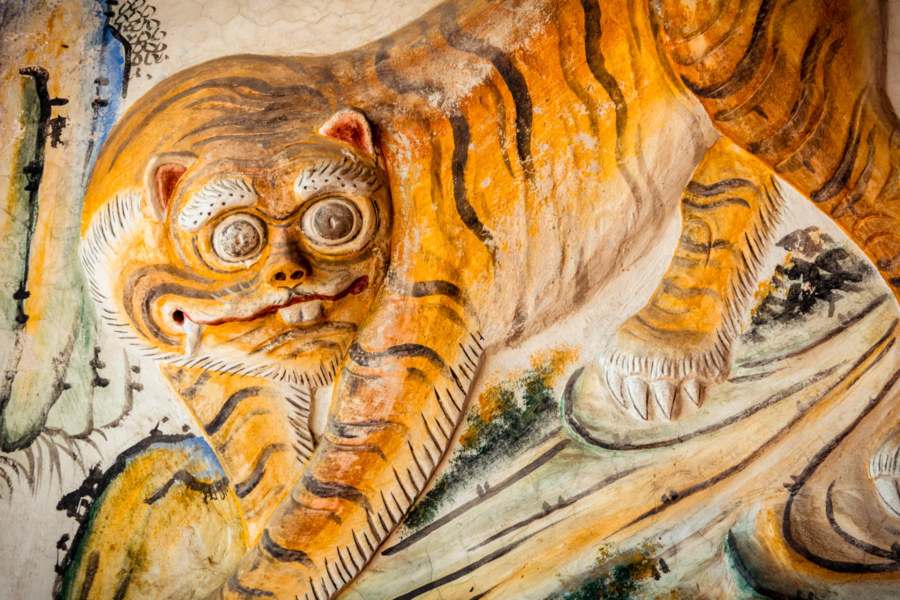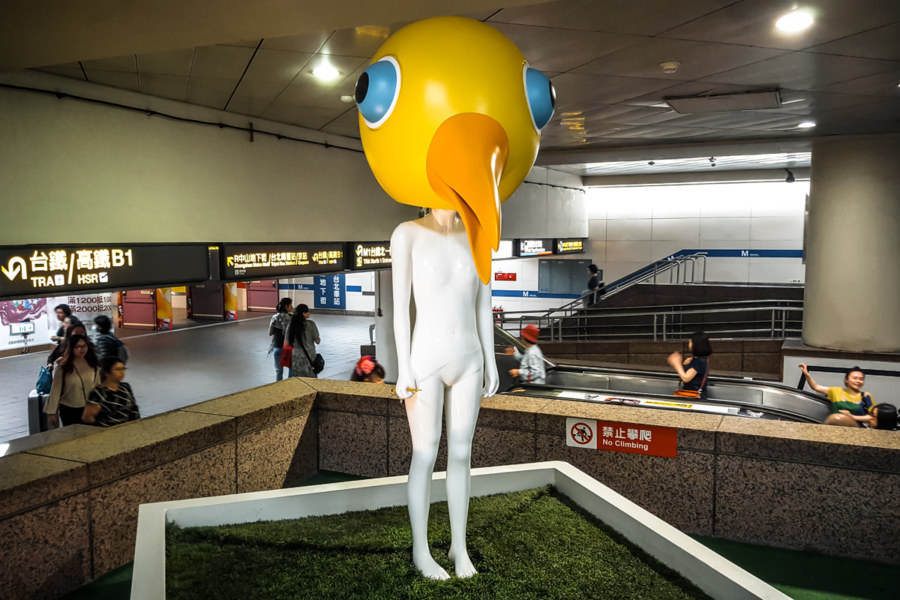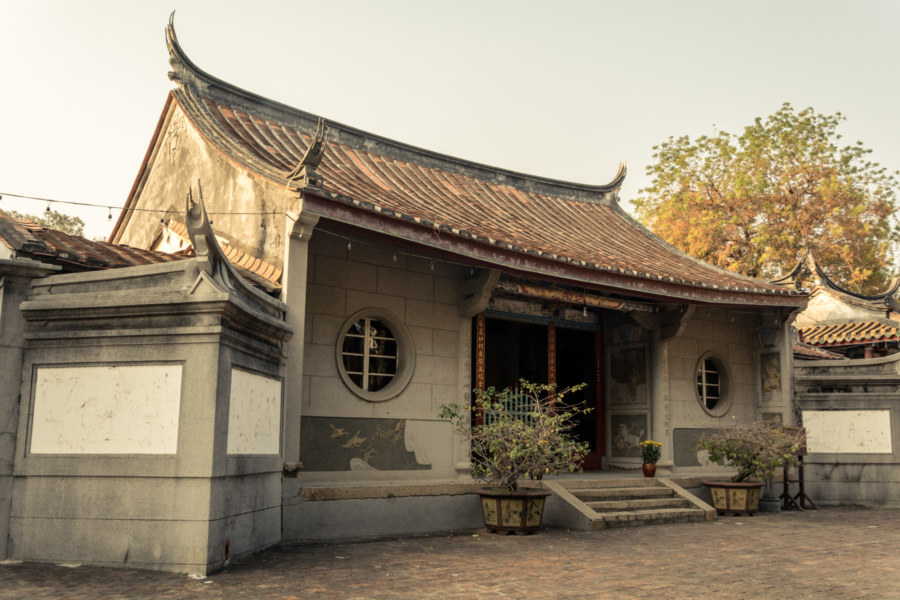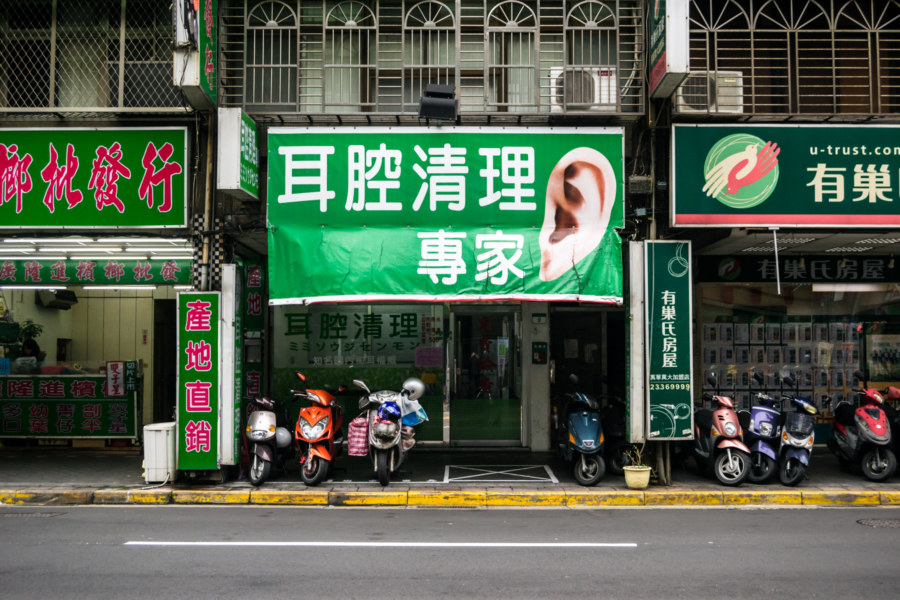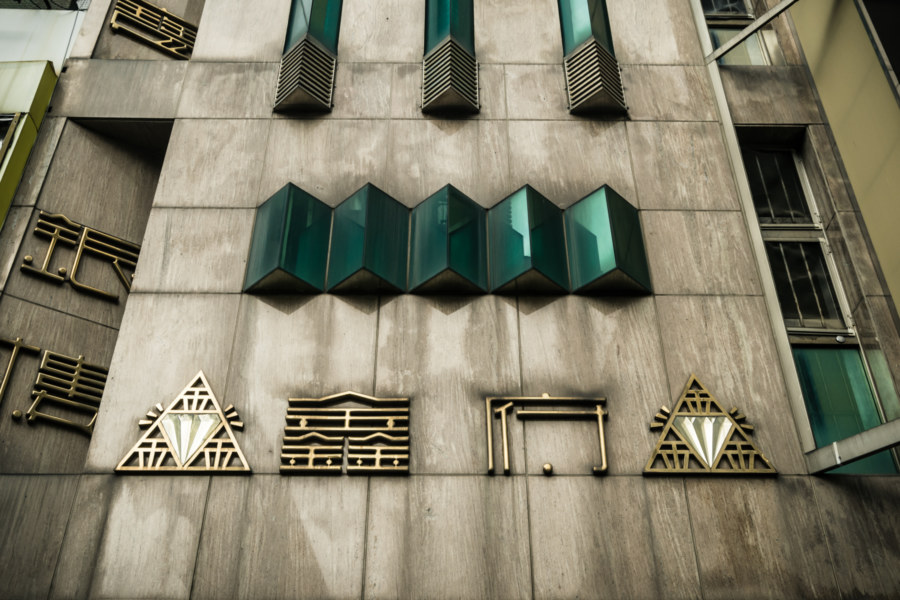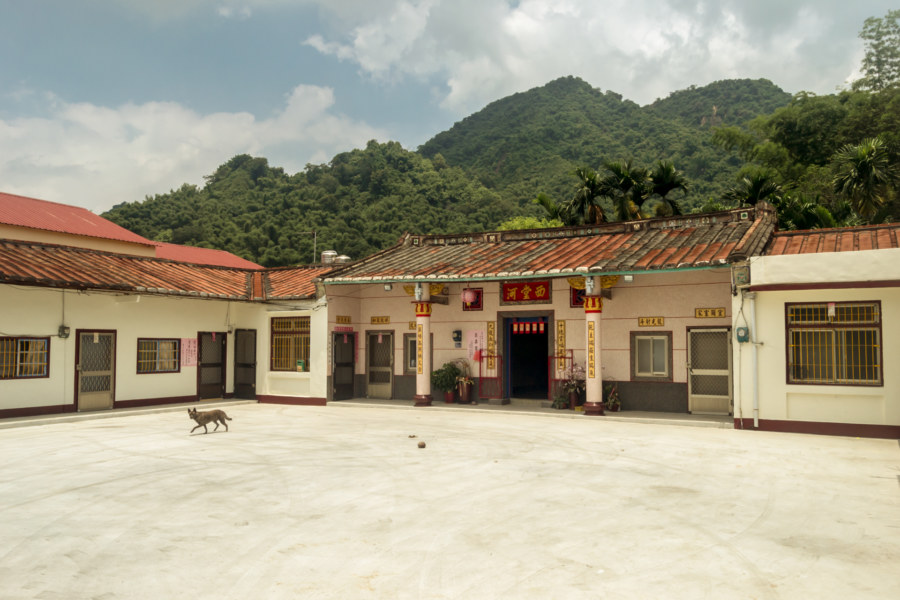Héngwén Temple 衡文宮 is located on the south side of Yuanlin, a mid-sized city in Changhua, Taiwan. Completed in 1976, this temple is mainly notable for its 72 foot-tall statue of Xuán Wǔ 玄武, literally “Dark Warrior”, alternately known as Xuán Dì 玄帝 (“Dark Deity”) or Xuántiān Shàngdì 玄天上帝 (“Dark Heavenly Deity”) among many other names. The statue itself is a hollow structure containing several additional floors filled with murals depicting the origins of Xuan Wu as well as various small shrines. A similarly oversized statue of Xuan Wu can be seen on the famous Lotus Pond 蓮池潭 in Zuoying, Kaohsiung, and there’s probably several more scattered around Taiwan, but this one is apparently the largest of its kind. Such claims are often difficult to verify as pretty much any temple with a big statue is likely to say the same thing.
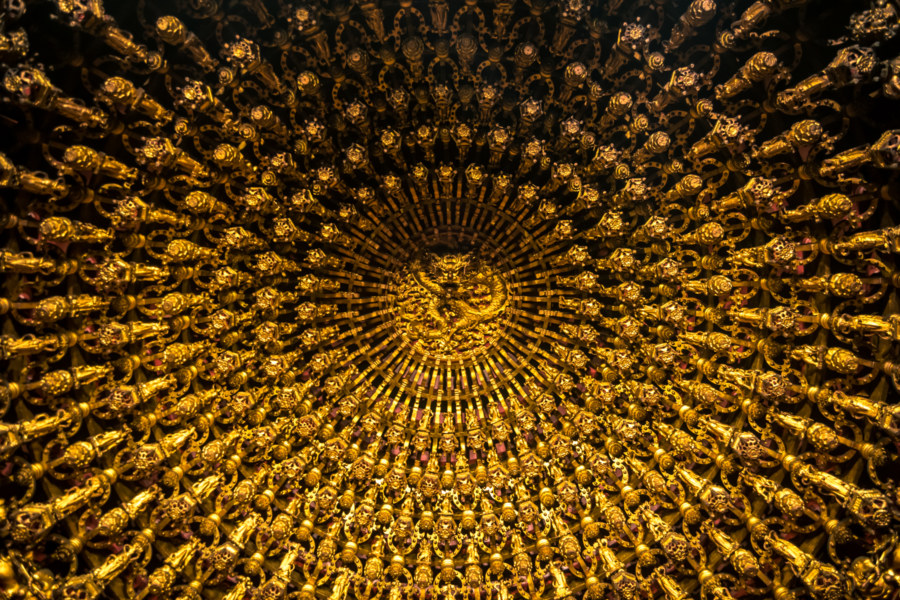
Cultural observations, insight, and confusion.
Taiwan Road Safety Dummies 1 台灣的工程用假人一號
Road safety dummies are a distinctive feature of the streets of Taiwan. In Chinese they are generally known as engineering dummies 工程用假人 (pinyin: gōngchéngyòng jiǎrén), warning dummies 警示假人 (jǐngshì jiǎrén), or, more formally, electric flag-bearers 電動旗手 (diàndòng qíshǒu). According to law these robotic figures must be setup at all roadside construction sites to provide some measure of protection for workers as well as warn passing motorists and pedestrians of potential hazards. When hooked up to a car battery their stubby arms pump up and down, waving flags and other objects to direct traffic. Construction companies typically decorate these dummies with safety vests and hardhats, though it is not common for workers to express some creativity and personalize their dummies. Some of them even have individual names and histories! The rest of this post features photographs of some of the many road safety dummies I have encountered over the years.
Jiahe New Village 嘉禾新村
Jiahe New Village (嘉禾新村) is one of more than 800 military dependents’ villages (Chinese: juàncūn 眷村) built in Taiwan in the late 1940s and 1950s to provide provisional housing for KMT soldiers and their families fleeing from the Chinese Civil War. Approximately two million people crossed the Taiwan Strait from China from 1945 to 1949, bolstering an existing population of approximately seven million. More than 600,000 of these Chinese immigrants ended up in military villages like this one in Zhongzheng, Taipei, which was forcibly abandoned only a couple of years ago as part of a wave of urban renewal projects sweeping the nation.
Lukang Yuqu Temple 鹿港玉渠宮
Yùqú Temple (玉渠宮) is a colourful temple in the back alleys of Lukang, one of the oldest and most traditional cities in Taiwan. Tracing its origins back to a simple shrine built in 1765, this small temple venerates Marshal Tian Du (田都元帥), the god of drama—and by extension traditional opera, theater, music, and other forms of performance art. Local gentry funded the construction of the first temple on this particular site in the twilight of Lukang’s commercial importance in 1902, during the Japanese colonial era. The temple underwent major renovations in 1967 and, in typical Taiwanese style, has been regularly improved and updated over the years.
Daodong Academy 道東書院
Dàodōng Academy (道東書院) is one of many Qing dynasty era academies scattered across central and southern Taiwan. Located in Hemei in Changhua, it was built in 1857, the 7th year of the Xianfeng Emperor (清咸豐七年), and operated as a private school devoted to classic Chinese literature, philosophy, and ethics, among other subjects. Commonly known to locals as Wénmiào (文廟, “Temple of Literature”), the academy also venerates Song dynasty scholar Zhū Xī (朱熹) and Kuí Xīng (奎星), the god of examinations.
The Birdman of Taipei Station
A bizarre work of public art in the bowels of Taipei Station.
This striking installation is one of the more iconic and well-known works of public art in Taipei. Created by artists Hé Cǎiróu 何采柔 and Guō Wéntài (郭文泰) in 2009, it is entitled The World in Aves’ Eyes (愛維思看世界), Birdperson (鳥人), or Daydreams (夢遊) and can be found somewhere in the labyrinthine passageways beneath Taipei Railway Station (臺北火車站). Apart from the obvious, the immature, androgynous figure holds a pencil in its right hand (never to write a word), water continuously seeps from its neck, and its feet show the signs of a mild case of pigeon toe, a condition that should be familiar to anyone who has seen young Taiwanese posing for photographs. Here is the original creative statement that accompanies the piece:
「愛維思看世界」以稚嫩的身體、怪誕逗趣的鳥頭以及輕輕淺淺的流水,表現出E世代對世界的困惑,身體的稚嫩感彷彿要告訴世界,還不急著要長大,而側著的鳥頭以不成比例的尺寸,誇張的標明著自我的異化感,猶如一位誤闖地球的外星人,在幽浮般的蛋殼中孵化而出。愛維思(Aves)搖搖晃晃的嘗試著適應這難以理解的世界,那漾漾清水則是一般腦傾洩而出的困惑,沒有黑暗、邪惡、憂傷或者種種成人世界裡的光怪色彩,愛維思(Aves)的苦惱是屬於孩童一般的天真困惑,在陽光的照耀下甚至會散射出七彩的光暈、迷霧而迷人。
My ability to translate Chinese remains limited, particularly when it comes to the sort of conceptual language employed above, but I’ll do my best to provide the gist. From what I can tell…
Tainan Fahua Monastery 台南法華寺
Last year I briefly visited the historic Fahua Monastery 法華寺 in Tainan. Like many of my explorations of temples in Taiwan this one wasn’t planned in advance. I noticed the monastery from the roadside while riding through the back streets south of the train station and stopped to check it out on a whim. As it turns out, Fahua Monastery has quite a long and distinguished history—going all the way back to 1684—and the interior is unusually minimalistic and serene compared to most other temples I have visited here in Taiwan.
Clean Your Head
Here’s something you might not have seen before: a professional ear cleaning service in Wanhua! When I shot this photo while riding around a couple of months ago I assumed it was a run-of-the-mill ear, nose, and throat doctor with a quirky sign out front. Turns out this is a famous shop by the name of Ěrqiāng Qīnglǐ de Jiā (耳腔清理的家, loosely: “Ear Canal Cleaning Home”) where you can have your ears cleaned by a “professional ear cleaning master” (zhuānyè tāo’ěr shī 專業掏耳師) for about 500 NT. Apparently Yáo Bīn (姚賓), the octogenarian proprietor, will be happy to show off jars filled with grotesque things he has unearthed over the course of five decades of aural spelunking.
A Gem of a Storefront
A classy storefront in Hsinchu not far from the train station.
This storefront immediately caught my eye when I arrived in Hsinchu a few hours ago. Both the facade and the lettering are unusually classy, showing a vintage style of design not commonly seen here in Taiwan. This is a jewelry shop, as the clever use of characters would suggest, and its formal name is Xīnfǔ Zhūbǎo 鑫府珠寶. The first character, xīn 鑫, is known as a sāndiézì 三叠字, or triplet character, and is composed of three instances of jīn 金, which means gold. Whoever designed the lettering obviously had some fun integrating a sparkling jewel into the two characters on either side of the shop’s name!…
Postcards From Meinong 美濃明信片
I briefly visited Meinong in July of 2014 while cycling around southern Taiwan. I hadn’t done any planning prior to arrival and knew nothing of what I was getting myself into nor what sights I should have made an effort to see. I was navigating almost exclusively by instinct, riding in whatever direction seemed interesting, simply to see what was there. Gathered here are several of my photos from a few uninformed hours in this bucolic rural township in Kaohsiung.
